Sourdough On A Budget: Easy + Cheap Sourdough Bread At Home
This post may contain affiliate links.
As the world we live in changes, you might have wondered how to make sourdough bread on a budget. Whether you are just looking to reduce your household expenditure or love the challenge of baking on a budget, here you'll find lots of tips and tricks to bake a lovely loaf of sourdough bread on a budget.
I've also included my sourdough bread recipe (on a budget) at the end of the post. You can bake good bread on a budget!
The fact is that getting back to basics has become very popular, particularly in the last few years.
But often simple hobbies can come with expensive price tags. This post aims to help you bake sourdough bread on a budget, without fancy tools or equipment, at least until you're ready to take the next step or take your hobby to the next level.
How To Bake Sourdough On A Budget
Here are my top 10 tips for baking sourdough bread on a budget:
- Buy a starter or get one from a friend
- Buy flour on sale or in bulk or look at cheaper alternatives
- Use a bowl, colander or ricotta basket for a banneton
- Look at alternatives for parchment paper
- Search thrift stores for Dutch Ovens & Clay Bakers
- Use a sharp knife or razor blade to slash the top of the dough
- Practice with "half" loaves to save on ingredient costs
- Bake 2 loaves at a time & freeze one to save time & electricity
- Explore cold start process for energy cost reduction
- Do your research to avoid wasting ingredients on failed bakes
Is It Cheaper To Make Your Own Sourdough?
Yes it's cheaper to make your own sourdough at home, as oppose to buying it from a bakery.
When you consider that sourdough is literally just flour, water and salt (including the sourdough culture), then depending on the type of flour you use, you could bake a loaf for as little as $1.
However, this cost does not include feeding your sourdough starter, your time or labor or the cost of electricity of equipment.
So if you look solely at the ingredients, it is cheaper to make your own sourdough. But if you bring other factors into it - it might not be as cheap.
This post aims to show you how you can bake a classic sourdough loaf with a little work and no fancy equipment.
The only recommended sourdough gear in this post will be things you already have at home or can source from a thrift store. Things like a kitchen scale, bench scraper, wire rack, wooden spoon and a large bowl for your bread dough are also handy and things you probably already have on hand.
If you don't have a kitchen scale on hand I strongly suggest you do invest in one. You can get them from as little as $10 and it's well worth the effort as it will ensure you have consistency in your sourdough baking and you're measuring exact ingredients with accuracy and no waste - which is important when you're trying to save money. You can read more about the benefits of weighing your ingredients here.
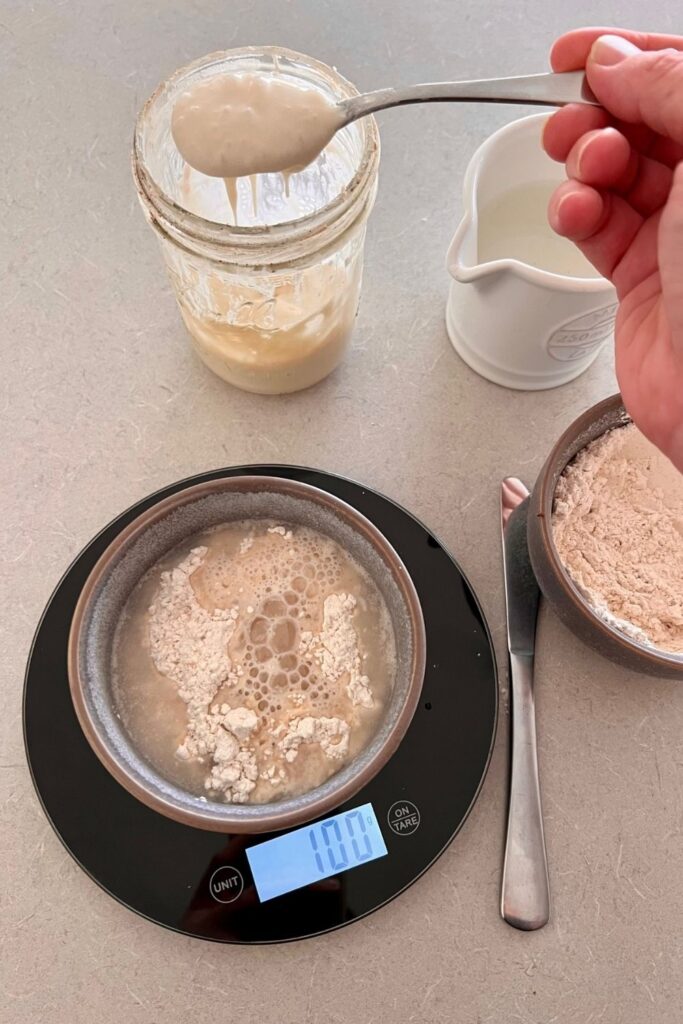
How Much Does It Cost To Make A Loaf of Sourdough Bread?
At its most basic calculation, a loaf of sourdough bread costs between $1 and $2 to bake at home (depending on the type of flour you use). If you add in your time/labor, as well as energy costs, you could be looking at anywhere from $5 to $20 a loaf. And then add the cost of equipment like dough whisks, Dutch Ovens and bannetons and you really have blown the budget!
Most home bakers wouldn't add in the cost of labor or electricity simply because they are baking for enjoyment, flavor or even to ensure they know what is actually in their bread.
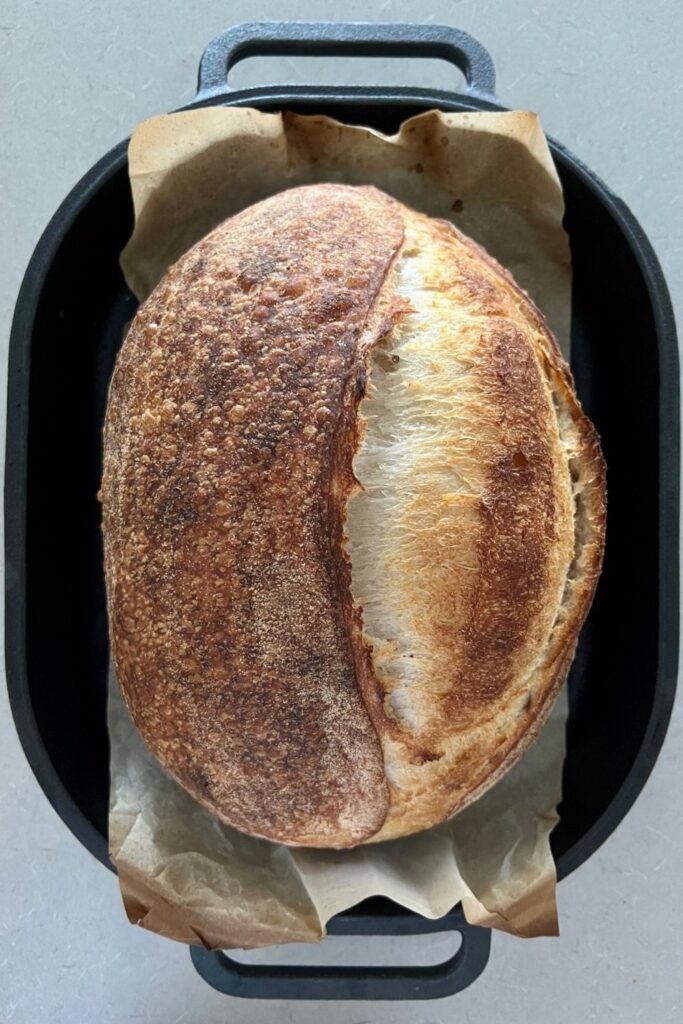
How Do You Make Sourdough Bread on a Budget?
To make sourdough bread on a budget you need to ensure that you are getting the best deal on your flour and making the most of the equipment you already have in your kitchen cupboards.
I also recommend purchasing a sourdough starter or acquiring one from a friend or neighborhood share group so that you don't have to pay for flour to establish your sourdough starter.
Let's look at how to bake sourdough bread on a budget in more detail:
Buy A Sourdough Starter (Instead of Making One)
If you are baking sourdough bread on a budget I recommend buying a sourdough starter. Yes that's right, it's actually cheaper to purchase a ready made sourdough starter than spend money on flour to establish a wild yeast colony yourself.
If you really want to be budget friendly, see if you can get one from a friend or "buy nothing" group on Facebook.
Buying a starter is also a really good idea if you're a busy mom trying to bake sourdough.
How Much Do Sourdough Starters Cost?
You can buy an established sourdough starter from Breadtopia for around $13. Once you receive it in the mail, you'll need to use around 200g of flour to activate it (full instructions here) and get it ready for baking. This will cost around $1, depending on the type of flour you use.
It is cheaper to pay $13 for an active sourdough starter that you can feed maybe 3 or 4 times before it's ready for baking - costing you a total of perhaps $15 than to establish a sourdough starter yourself.
Establishing a sourdough starter from scratch can take up to 3 to 4 months before you actually have a viable, usable starter that makes decent, edible sourdough bread. If you feed your starter twice a day for say 12 weeks that would be 16.8kg of flour (if you fed it 50g at each feed). You could also just make a smaller sourdough starter (and use less flour at each feed).
So you can see how purchasing one or of course, acquiring one for free, would be the more budget friendly option. Now of course, I teach people to make their own sourdough starter from scratch - so I'm all for the challenge of making something yourself - so don't discount this option entirely, but it is good to look at the overall cost of things so you can make an informed decision.
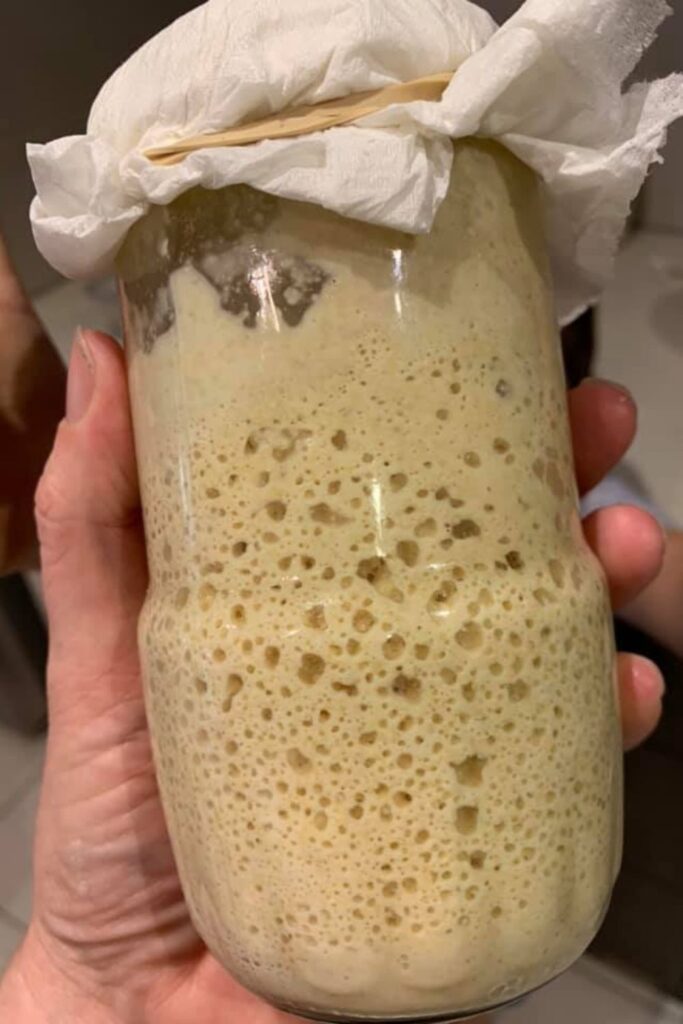
Sourcing Flour for Budget Sourdough
The average sourdough loaf takes 500g of flour, plus a few feeds for your sourdough starter at 50g each. So let's say 600g of flour. If you are making a loaf a day, this will add up to 4.2kg of flour a week. Now it doesn't sound a lot, but it sure can add up over a year. So to bake sourdough on a budget, you'll need to source the best flour at a budget price.
The type of flour you choose for sourdough is important. Bread flour is best due to its high protein content, however it is possible to use All Purpose Flour with a few tweaks. Whole wheat flour is also popular for sourdough bread, but can be expensive when compared with white flour.
The trick here is to look at the different flours available and what will give you the best bang for your buck. The brand of flour you choose will make a difference.
King Arthur Bread Flour is really popular with sourdough bakers and home bakers alike (at least in the United States), however it is often priced much higher and you can often find similar alternatives with a lower price point. A little effort goes a long way, even when researching your flour for sourdough!
Another alternative is to buy a softer flour (like an all purpose) and add a small amount of vital wheat gluten.
The cost of your flour is really going to depend on where in the world you live and what is readily available to you. Remember if you do buy your flour in bulk to save money, you'll need a reliable method to store your flour and keep it fresh.
You may also want to have some rice flour on hand for dusting your proofing basket. Rice flour can be really cheap to buy at your local Asian grocer or you can even make your own if you have a food processor at home.
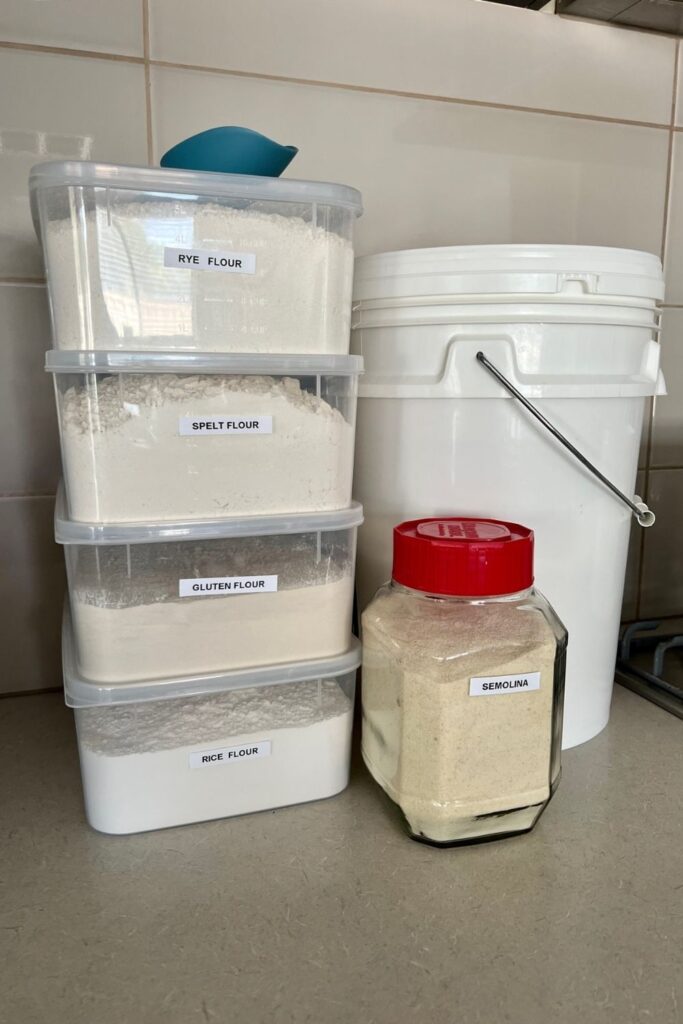
Banneton on a Budget
If you want to start small and then buy things as you need them, using something you already have on hand in your kitchen cupboard for a proofing basket is one of the easiest ways to save money when baking sourdough bread.
I've written an extensive list of proofing basket alternatives here. Some of the most popular alternatives are using a bowl, a small colander or even a ricotta basket. These are things that you might already have on hand in your kitchen. You can even use a tea towel and rubber band!
It is important to use something that will support your sourdough while it rests. Choosing something that allows your dough to spread out too much will cause problems when you go to bake your bread.
Another money saving tip is to use a plastic bag to cover your banneton while the dough rests. I often use the plastic bags I get from the supermarket when I buy apples or oranges and repurpose them. This will reduce your need for using plastic wrap as the bag can also be used to cover your dough while it bulk ferments too.
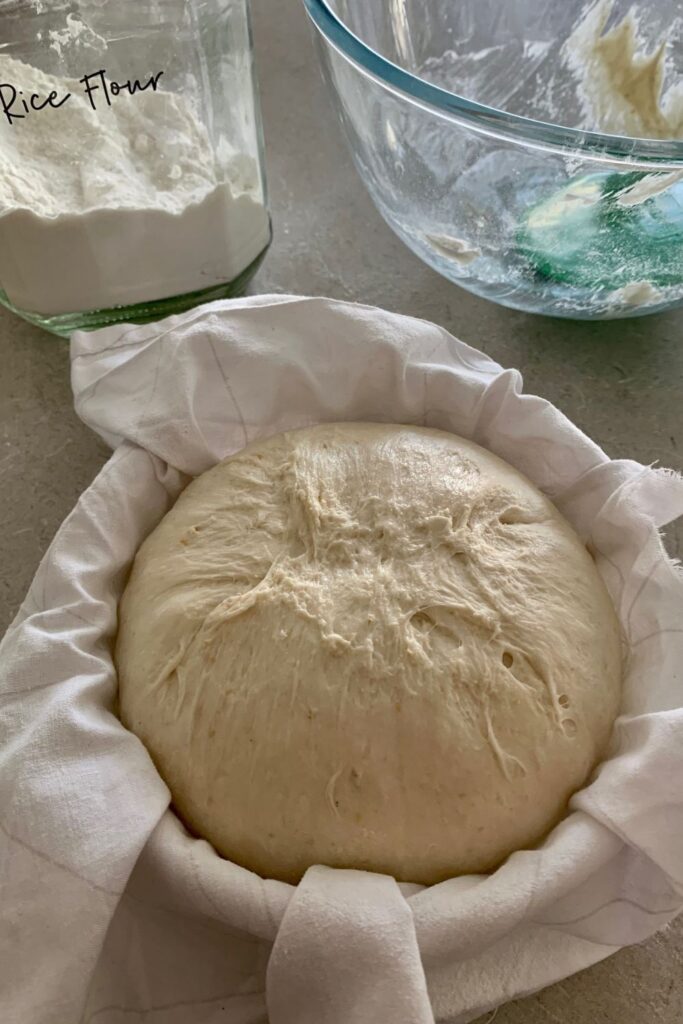
Alternatives To Parchment Paper
If you are using a sheet of parchment paper every time you bake sourdough, this can cost a pretty penny. Particular if you're using a more expensive brand, as is often necessary to stop it sticking to your dough whilst baking.
Investing in a silicone sling can avoid constantly buying rolls of parchment paper, but you might also be able to use a bread peel. You'll find a full guide to using alternatives to parchment paper here.
Search Thrift Stores for Equipment
I've seen so many people in my Facebook Group find amazing sourdough baking equipment for bargain prices in their local thrift store! From clay bakers to Dutch Ovens, casserole pots and bannetons and everything in between. Even good a quality large mixing bowl and baking stones! In fact so many people find clay baking pots at thrift stores and then ask how they can use them, I ended up writing this post on how to bake sourdough bread in a clay baker to help them out.
There's no limit to what people donate to thrift stores, particularly if those items are from abandoned hobbies (hello sourdough bread baking). But their loss is definitely your gain!! So before you consider buying new, definitely see what you can find second hand.
Even asking family and friends if they have a Dutch Oven sitting at the back of their kitchen cupboards you could use - you just never know if you don't ask!
If you really can't find a Large Dutch Oven or pot at your thrift store you can use these alternatives to baking sourdough without a Dutch Oven.
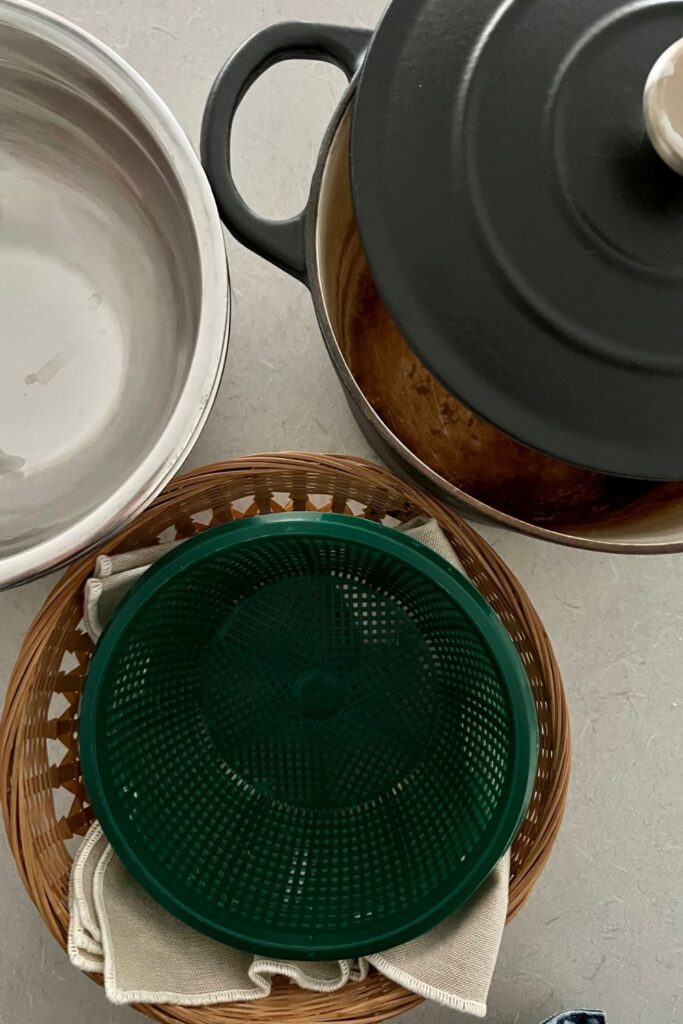
you never know what you might find!
Use A Sharp Knife or Razor
A baker's lame is the best way to slash or score your sourdough bread before baking. But if you aren't interested in fancy designs and you're just giving your bread one or two utility scores, then a sharp knife or even razors from the hardware store work perfectly. A serrated knife is great for slicing sourdough bread once it's baked, but not for slashing your dough.
Bake "Half Loaves"
This is a good idea, particularly when you're just starting out with sourdough. Halve the recipe you're baking (or split it into two loaves). This way you are minimising the ingredients you're using (and if the bread fails, you haven't wasted so much). This is a great way to practice sourdough without the extra cost. You might also like my small batch sourdough loaf recipe.
Another tip is not to use extra ingredients - so stick to your flour, water, salt - at least for the first few bakes. While olive oil and a pinch of sugar can be useful additions to your sourdough, to keep costs low, stick to the basics.
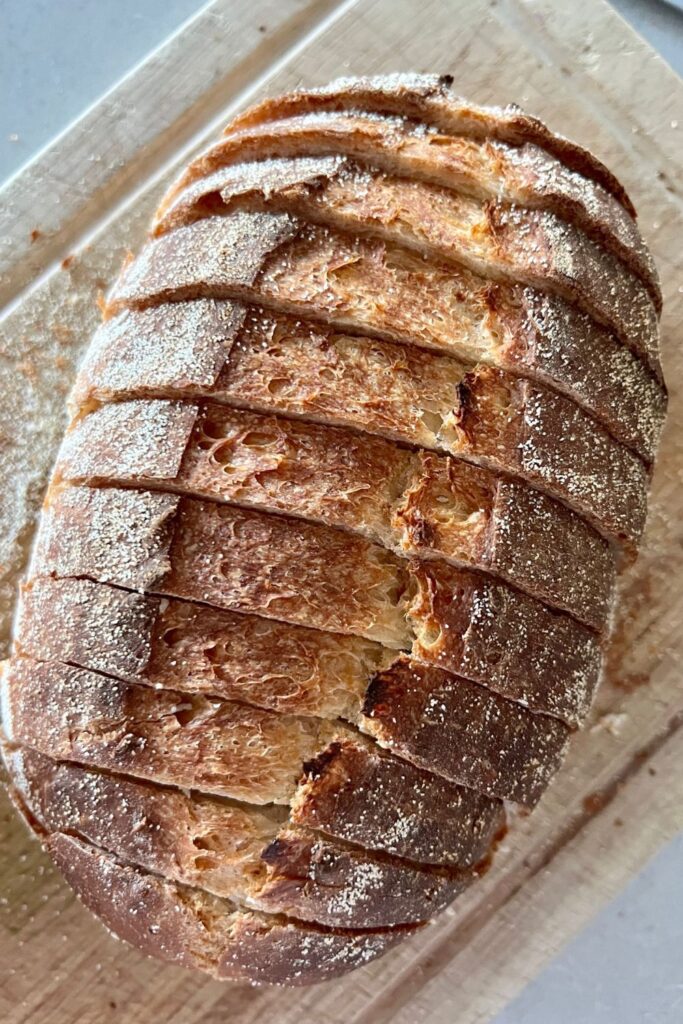
Bake to Freeze
Once you're a bit more established as a sourdough baker, you can bake 2 or even 3 loaves at a time to save money. You really use the same amount of time and labor to prepare two loaves as would one, so you may as well, right?
Then if you don't need 2 loaves, place one in the freezer for another day. Baking 2 or even 3 loaves at a time reduces not only your labor, but also your energy costs since the oven is already on and preheated.
Many home bakes utilise the hot oven for multiple sourdough bakes, saving them time and money in the long run. And you never know when that extra loaf in the freezer will come in handy!
You'll find my guide to baking multiple sourdough loaves at once here and a full guide to freezing sourdough bread here.
Explore Cold Start Method
Now if you've been following me for a while, you'll know I absolutely implore that you need a hot Dutch Oven to bake your sourdough bread - and I absolutely stand by that!
However, as this is a post about baking sourdough on a budget, it would be remiss of me to leave out the issue of energy costs. Preheating your oven and then baking sourdough can mean that your oven is on for up to 2 hours, which is quite a long time, particurlarly if you're only baking one loaf at a time (which is why it can be better for your hip pocket to bake two or more in one bake).
But if you really are struggling with energy costs, you may want to explore using a cold start for your sourdough bread as opposed to a hot oven. I have included this option in the recipe at the end of this post. Alternatively, you could bake sourdough bread in a slow cooker to reduce your energy costs.
Using a cold start method means loading your bread dough into a cold oven and then turning it on rather than using a preheated oven. You can either use a baking stone or a Dutch Oven or even enamel turkey roaster (these are often found at thrift stores).
There are definitely a few tweaks you will need to make to ensure that you get good results from this method. You don't want all your hard work to go to waste!
You'll find some further information on this method in the recipe card at the end of this post.
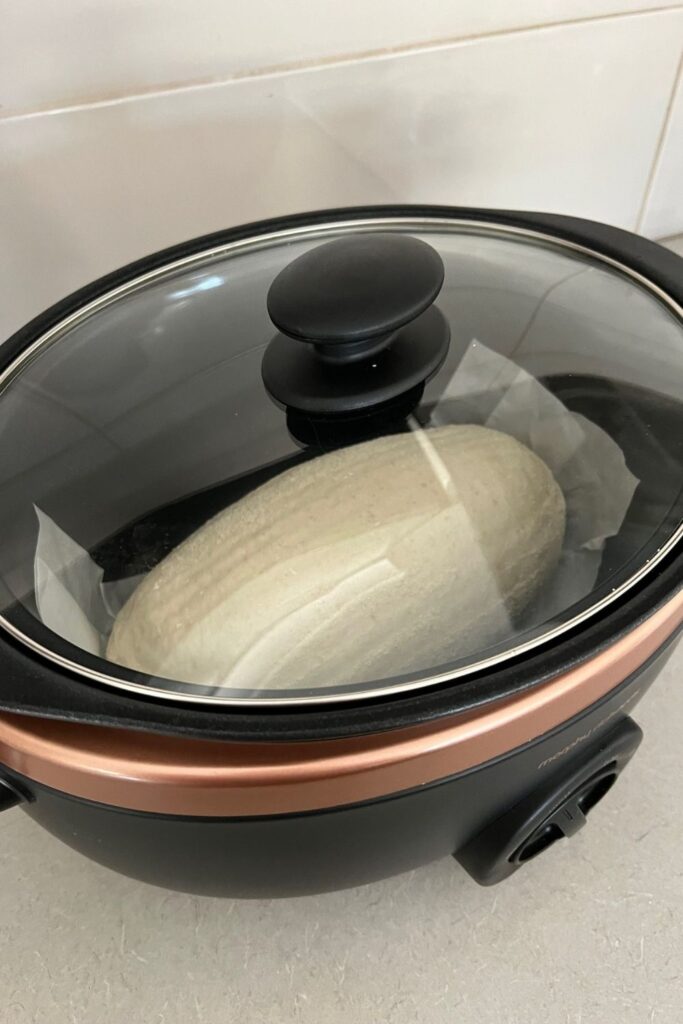
Increase Your Sourdough Knowledge
This might sound like a crazy suggestion, however, the more you know about the nuances of sourdough baking, the better chance you have of baking successful loaves straight off the bat. This decreases your chance of wasting time, flour and electricity - all of which will ultimately cost you money.
Understanding terms like bulk fermentation, oven spring and ambient temperature will stand you in good stead for baking sourdough loaves with high rise. This sourdough glossary is a great place to start building your sourdough knowledge.
Things like baking sourdough at high altitude can be a real challenge. However, with a bit of know how, you can still bake amazing sourdough. It just takes a few tweaks (and you can find my full guide to baking sourdough at altitude here).
Or perhaps you really want to get an open crumb sourdough. Understanding what you need to tweak in order to bake the bread you want will allow you to bake better bread sooner, which will save you money in the long run.
Best Sourdough Recipes On A Budget
When baking homemade sourdough bread on a budget, you need easy sourdough recipes with minimal ingredients. Recipes that utilise the discard you create are also a great way to minimise waste and save you cash. Here are my favorite budget sourdough recipes for you to try:
- Sourdough English Muffins
- Sourdough Crumpets
- Sourdough Discard Pizza Dough
- Sourdough Focaccia Bread
- Sourdough Overnight Bagels
- The Easiest Sourdough Discard Bread Ever!
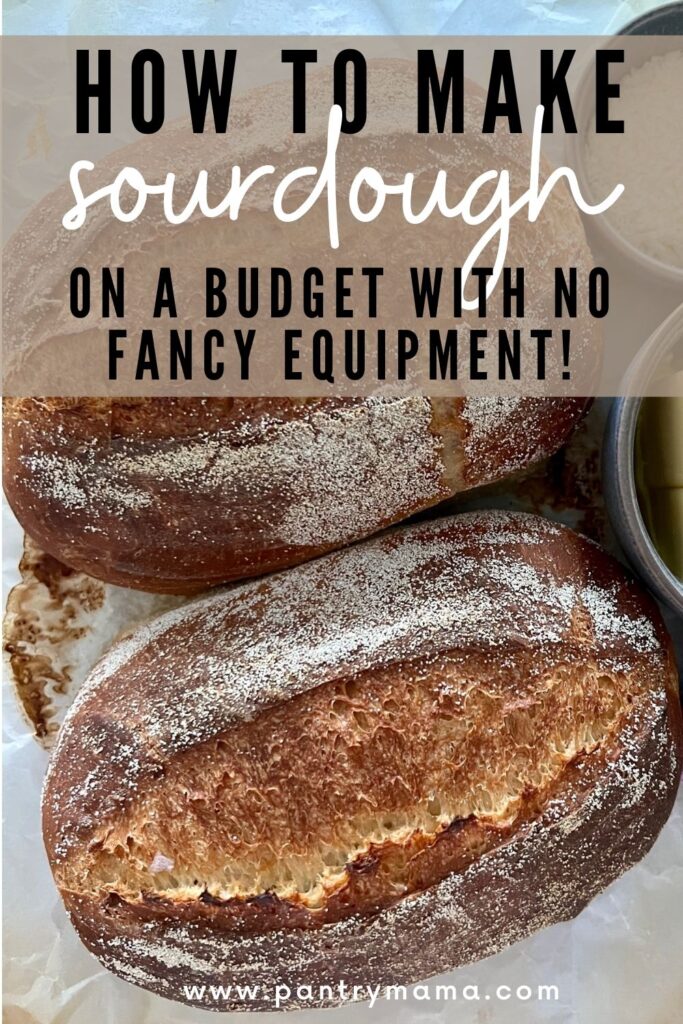
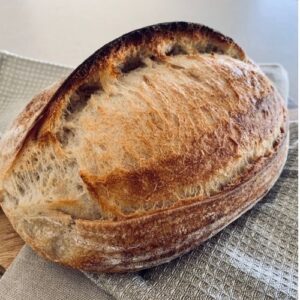
Sourdough Bread Recipe on a Budget
Equipment
- Basic Kitchen Scale (grab them for as little as $10 here)
Ingredients
- 500 g Bread Flour 100%
- 350 g Water 70%
- 50 g Sourdough Starter 10% (Fed and Bubbly)
- 10 g Salt 2% (increase or decrease according to your taste)
Instructions
- Autolyse - Premixing The DoughWeigh out your sourdough starter and water into a large mixing bowl - whatever you have in the cupboard is fine!Glass is always good as you can see what's happening underneath your dough. But any plastic, ceramic, stainless steel or glass bowl is fine! Mix the water and starter together briefly. Then add your flour and salt and mix whole lot together to form a shaggy dough. The dough will be fairly shaggy and only just brought together (see photo). You might wonder how this will turn into bread, but just wait, time is your friend and the dough will change in around an hour.
- Cover your bowl with a damp tea towel and let it sit for around 1 hour. It's ok if it's a little bit longer, it's not going to matter too much.This process is called the "autolyse" and allows your flour to soak in all the water and become hydrated.
- Forming Up The DoughAfter the dough has been through autolyse you need to bring it together into a ball. Work your way around the bowl, grabbing the dough from the outside, stretching it up and over itself, into the centre, until a smooth ball is formed. You shouldn't need more than about 20-25 stretches to form the ball.You'll notice that the dough is fully hydrated after soaking all the water up. It will be fairly sticky but as you bring it into a ball, it will become smoother and shinier.
- Once the dough has formed into a smooth ball, pop the damp tea towel back on and let it rest for 30 minutes.
- Stretch & Fold - Creating StructureOver the next few hours you need to create some structure for your dough by "stretching and folding". Aim to do around 4-6 sets of stretches and folds. For each set, stretch the dough up and over itself 4 times. Leave around 15 minutes in between each set. Again you do not have to be exact with time, but you need to do at least 4 sets over 2 hours.I like to be fairly liberal with my timings as I am generally cooking amongst the chaos of family life and therefore sometimes timing does go astray!
- Bulk FermentOnce you've finished your stretch and folds, cover the dough with a plastic cover (a recycled plastic bag is perfect) and allow the dough to double (bulk fermentation).See notes below for more info on this step.
- Shaping The DoughOnce your dough has finished its first ferment, it's time to shape it into either a boule or a batard. You'll need to flour your counter top with rice flour for this (we use rice flour because it has no gluten). Try to be quite sparing with the rice flour, you only need a very light dusting.Use a dough scraper to gently ease the dough out of the bowl (your hands work just fine if you don't have one). You want it to land upside down on your counter so that the smooth top of the dough is on the countertop and the sticky underside is facing up. This will make it easier to shape.You want to pull the edges of the dough into the centre and then flip it over so that the sticky side is now underneath. Using the stickiness, gently pull the dough into a tight ball.You will need a proofing basket or container to put your dough into. If you do not have a banneton, then a bowl or basket lined with a floured tea towel is perfectly fine. Make sure your bowl isn't too big though, you want your dough to retain some shape. You can find more notes on what to use as a banneton here.Whatever you're using needs to be liberally floured with your rice flour. If you're using a cloth or tea towel, rub the flour into it to ensure it becomes non stick (see notes here for details on this).
- Placing Into A Proofing ContainerOnce the dough is shaped into a tight ball, place it into your proofing basket or container smooth side down, so your seam is on the top.If you're using a cloth or tea towel in a bowl it's ok to put your dough with the smooth side up. Just make sure the dough is tight.Lift your dough around the edges to pop a little more rice flour if you feel it needs it. Just try to handle the dough as little as possible and be really gentle as you really want to preserve all the gases and air bubbles that have formed during your bulk ferment.
- Cold FermentNow the dough is in its "shaping container" cover it loosely with a plastic bag and place into the fridge. I use a large plastic bag to cover it - I just reuse it each time. Try to leave it in the fridge for a minimum 5 hours up to a maximum of around 36 hours. The longer you leave it the better your bread will be! A longer cold ferment creates beautiful blisters on your crust and a deeper sourdough flavour. It will also ensure your dough forms a skin which makes it easier to score.
BAKE YOUR SOURDOUGH ON A BUDGET - CHOOSE ONE OPTION
- BAKE OPTION 1 - PREHEATED DUTCH OVENOnce you're ready to bake your sourdough, you'll need to preheat your oven to 230C/450F. Place your Dutch Oven into the oven when you turn it on so it gets hot. Try to preheat for around 1 hour to ensure your oven is super hot - but you know your oven so just adjust this time if you need to.Leave your dough in the fridge until the very last minute - placing a cold dough into a hot oven will give you a great "spring".When your oven is at temperature, take your sourdough out of the fridge. Gently place it onto a piece of parchment paper or silicone sling if using. Gently score your bread with a clean razor blade or knife. At minimum a large cross is sufficient, but you can get as artistic as you like. You can find my full guide on how to score sourdough bread here.Carefully take your dutch oven out of the oven. Place the sourdough into the pot using the silicone sling or parchment paper as a handle. Put the lid on and place into the hot oven. If you want to you can spritz your dough with extra water before you put the lid on.BAKE TIME:30 Minutes with the lid on at 230C/450F plus10-15 Minutes with the lid off at 210C/410F
- BAKE OPTION 2 - PREHEATED WITHOUT DUTCH OVENOnce you're ready to bake your sourdough, you'll need to preheat your oven to 230C/450F. Ensure that you have placed a baking stone in the oven if you are going to use one. For more information on baking without a Dutch Oven see here.When your oven is at temperature, take your sourdough out of the fridge. Gently place your dough onto a bread peel or into your preferred baking method (enamel roasting pan/pot, casserole dish, stainless steel pot etc).Gently score your bread with a clean razor blade or knife. At minimum a large cross is sufficient, but you can get as artistic as you like. You can find my full guide on how to score sourdough bread here.Place your dough into the oven.BAKE TIME:20 minutes at 230C/450F plus25 to 30 minutes at 210C/410F
- BAKE OPTION 3 - COLD START OVENTake your sourdough out of the fridge and place into your preferred baking pot (Dutch Oven, enamel roaster etc). Gently score your bread with a clean razor blade or knife. At minimum a large cross is sufficient, but you can get as artistic as you like. You can find my full guide on how to score sourdough bread here. Place the pot containing your dough into the oven and then turn the oven on.BAKE TIME:50 Minutes at 230C/450F then turn the oven off and remove the bread from the pot. Place the bread back into the oven directly onto the rack and allow to cool in the oven with the door ajar.
- Finishing The BakeWhen you remove your dough from the oven, carefully remove it from the oven as soon as possible and place on a wire rack to cool.
Notes
- Notes on Flour: This recipe is written using strong Bread Flour. Bread flour has a higher protein content than All Purpose flour. If you choose to use All Purpose flour you may have a different result because of this. You can read more about the differences between All Purpose Flour and Bread Flour here.
- Notes on Sourdough Starter: This recipe is based on you having an active starter that you have fed a few hours before starting your bake. For info on how to make a sourdough starter, go here.
- Notes on Stretch & Folds: If you are going to do the stretch & folds on your bench top, spray your surface with water mist rather than using flour. You can leave the dough in the bowl if you want to. Wet your hands to stop the dough sticking - although it shouldn't be too sticky. It will get less sticky as you do your stretches and folds. For more information on how to do stretch and folds, go here.
- Notes on Bulk Fermentation: If your home is warm then your dough will ferment a lot faster and could be done in as little as a few hours. If it's colder, it will take longer, possibly overnight.
I would recommend that you try to do your first few bulk ferments during daylight hours so that you can watch your dough closely.
Once you're more familiar with the process - and the temperature of your home - you will be able to do overnight ferments. You will know your dough is ready to move to the next stage when it has *just* doubled in size. It will be fairly wobbly and full of bubbles. You should be able to see large air bubbles under the surface of the dough.
You don't want to let it go any further than doubled as it will be over fermented.
If you want to do an overnight ferment, but your home is warm, consider using a little less starter (ie 25g).
Less starter means your dough will take longer to ferment and you will reduce the risk of over fermenting your dough. You'll find more information on these topics here:
When is my bulk ferment finished? What is the difference between cold ferment and bulk ferment? Why does the amount of starter matter?
- Notes on Baking: If you're worried about the base of your bread burning, place a baking sheet on shelf underneath your Dutch Oven - it works! If you're worried about your bread not being cooked all the way through, turn the oven off and place your dough straight onto the oven rack. Leave the door ajar and let your bread rest there for a few hours. Make sure you don't close the door or your sourdough will sweat and you'll get a wrinkly, soggy crust. Remember not to cut into your loaf too soon - you'll need to let it cool for at least a few hours (4-6 is best).
Nutrition

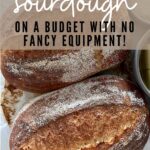
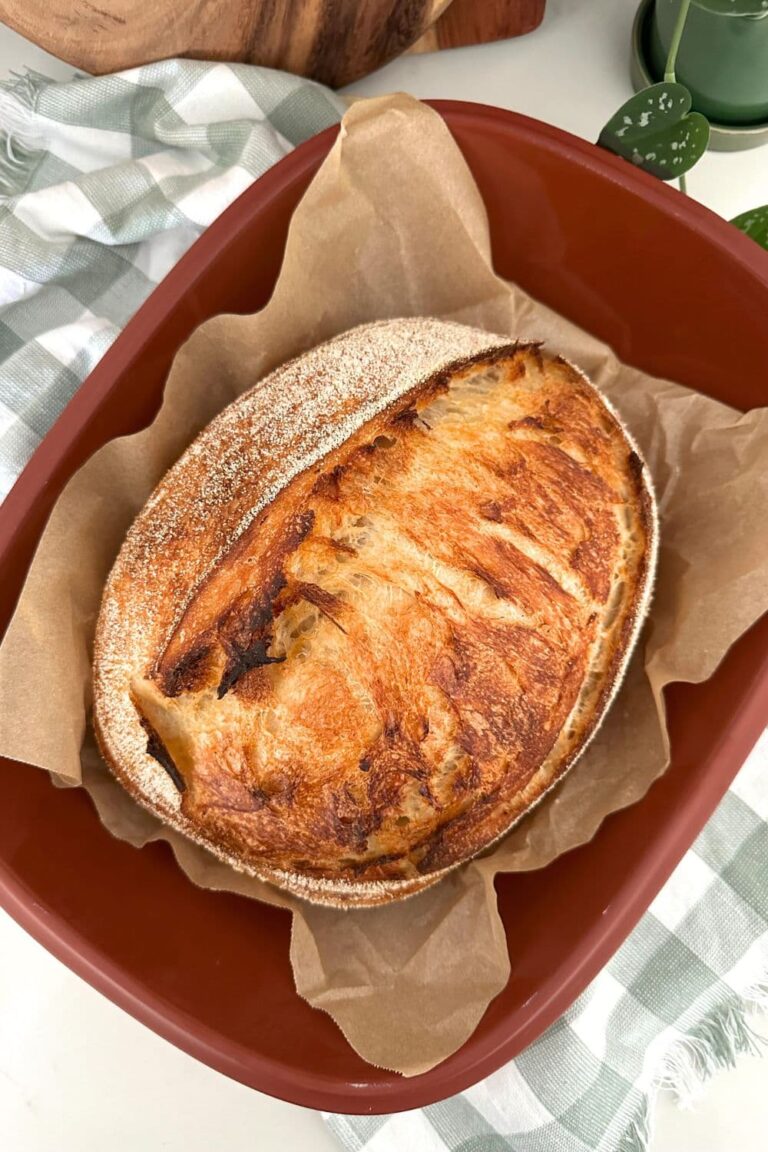
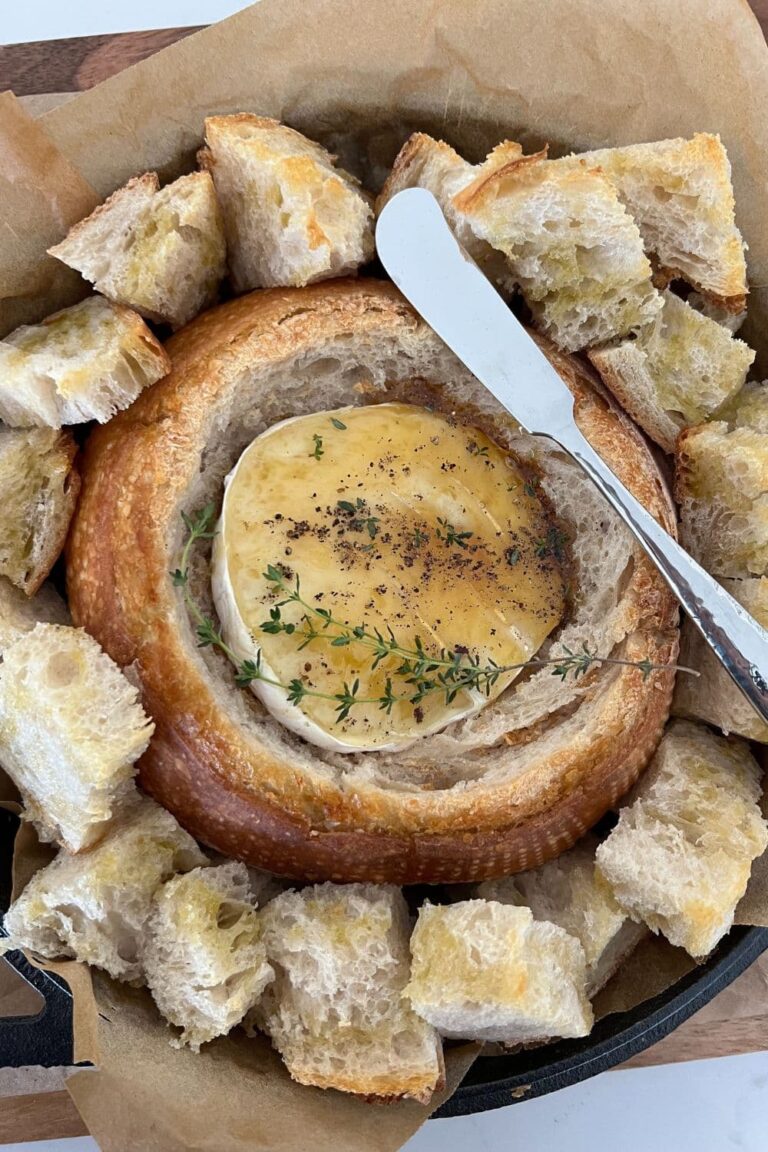
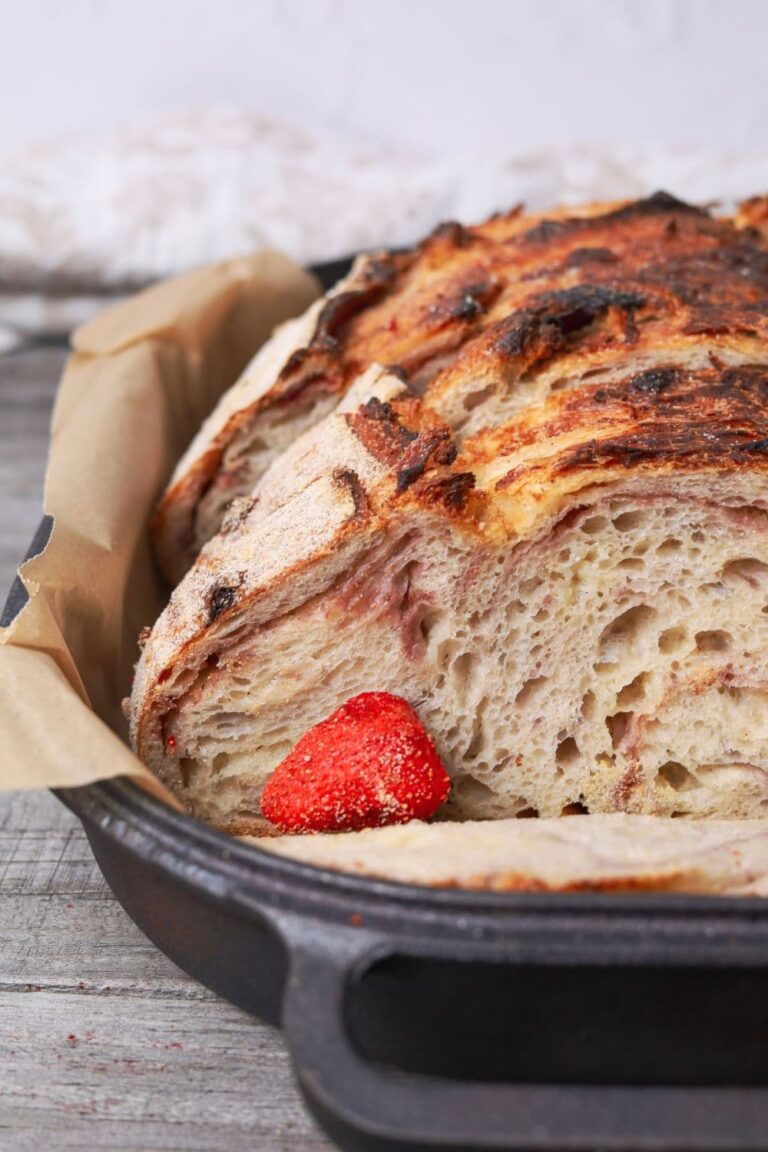
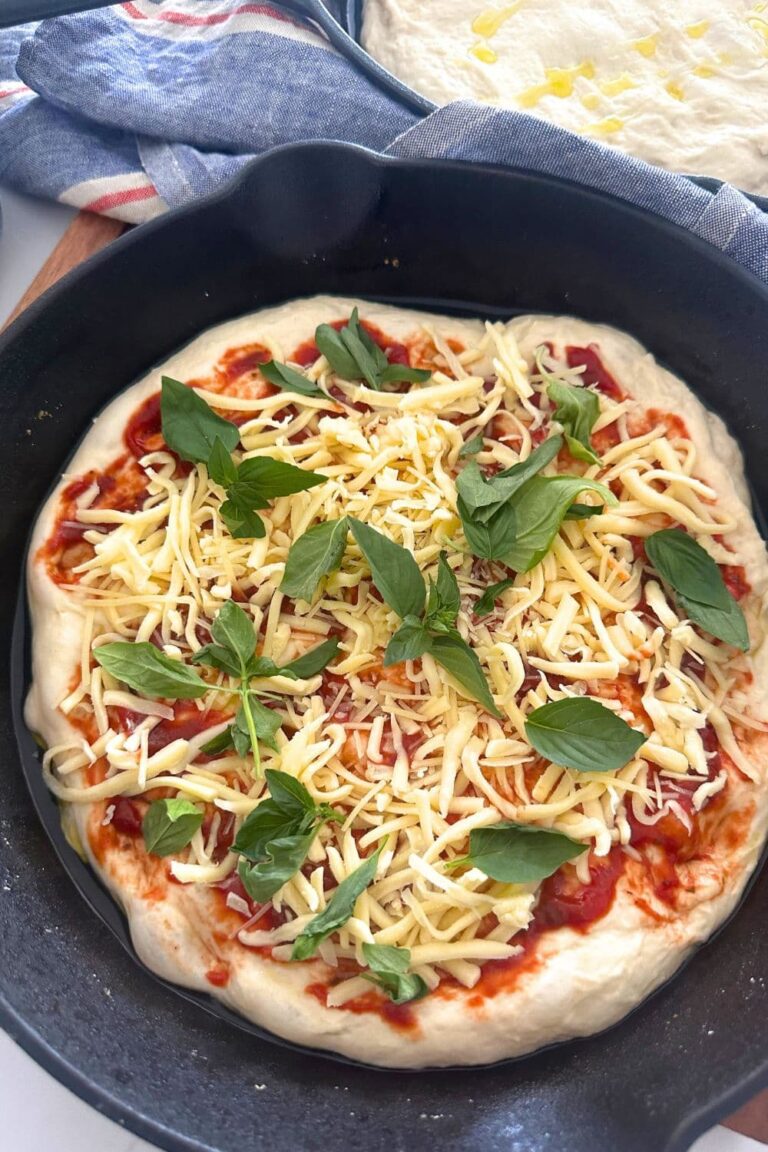

Thank you- would doubling or tripling this recipe work okay?
Yes you can easily double or triple - just separate into loaves after bulk fermentation 🙂
I am rating the tremendous amount of good content in here with perfect amount of detail. Thank you.
I forgot to bulk ferment. It went straight into the fridge after 5 - 6 hours of stretch and folds. Will it be alright?
Bulk fermentation is where all the magic happens, so you really don't want to skip this step. You can read about why here.